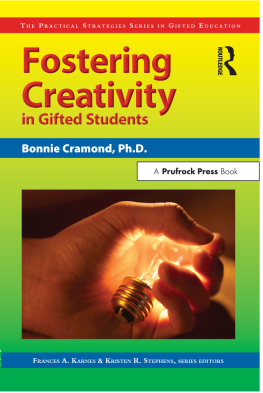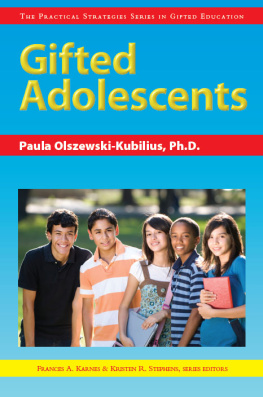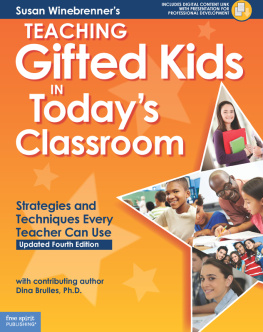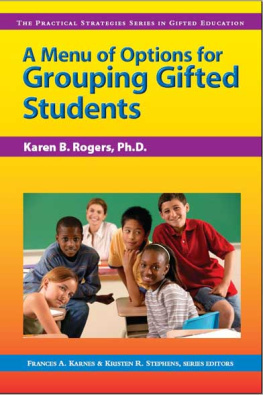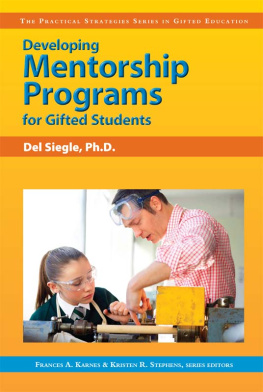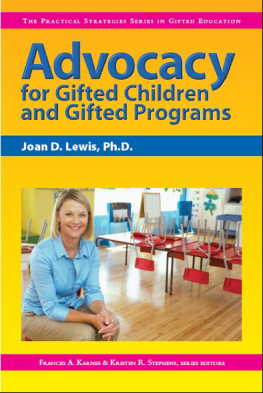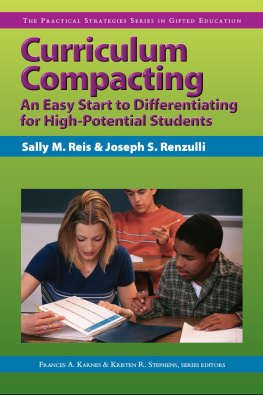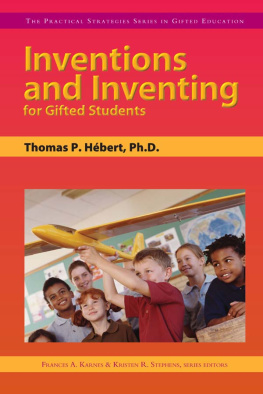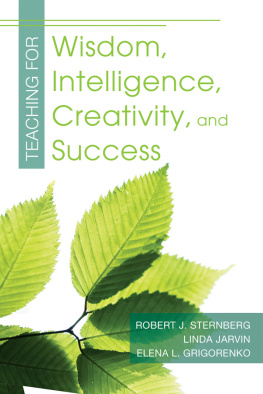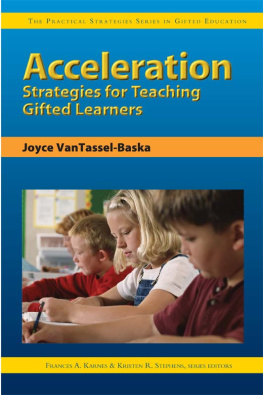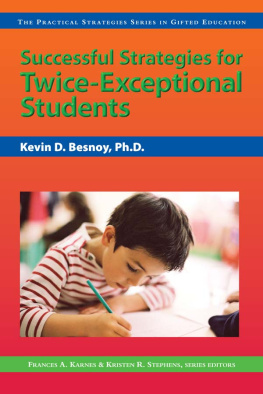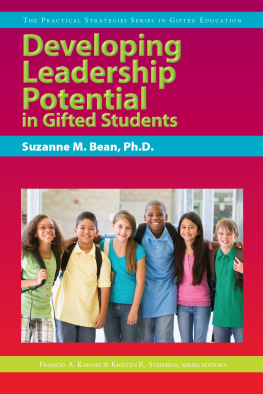
THE PRACTICAL STRATEGIES SERIES IN GIFTED EDUCATION
series editors FRANCES A. KARNES & KRISTEN R. STEPHENS
Fostering Creativity in Gifted Students
Bonnie Cramond

First published in 2005 by Prufrock Press Inc.
Published in 2021 by Routledge
605 Third Avenue, New York, NY 10017
2 Park Square, Milton Park, Abingdon, Oxon OX14 4RN
Routledge is an imprint of the Taylor & Francis Group, an informa business.
Copyright 2005 by Frances A. Karnes
and Kristen R. Stephens-Kozak
All rights reserved. No part of this book may be reprinted or reproduced or utilised in any form or by any electronic, mechanical, or other means, now known or hereafter invented, including photocopying and recording, or in any information storage or retrieval system, without permission in writing from the publishers.
Notice: Product or corporate names may be trademarks or registered trademarks, and are used only for identification and explanation without intent to infringe.
ISBN-13: 978-1-5936-3173-4 (pbk)
DOI: 10.4324/9781003235231
Contents
Guide
The Practical Strategies Series in Gifted Education offers teachers, counselors, administrators, parents, and other interested parties up-to-date instructional techniques and information on a variety of issues pertinent to the field of gifted education. Each guide addresses a focused topic and is written by scholars with authority on the issue. Several guides have been published. Among the titles are:
- Acceleration Strategies for Teaching Gifted Learners
- Curriculum Compacting: An Easy Start to Differentiating for High-Potential Students
- Enrichment Opportunities for Gifted Learners
- Independent Study for Gifted Learners
- Motivating Gifted Students
- Questioning Strategies for Teaching the Gifted
- Social & Emotional Teaching Strategies
- Using Media & Technology With Gifted Learners
For a current listing of available guides within the series, please contact Taylor & Francis at (800) 998-2208 or visit http://www.Taylor & Francis.com.
DOI: 10.4324/9781003235231-1
Is it possible to teach someone to be creative? Is it possible to teach someone to be intelligent?
In both cases, Id say the answer is no. But, we can teach students to use the creativity and intelligence they have. We can teach them to think more creatively and/or intelligently. We can encourage them to value, practice, and evaluate their own creativity or intelligence. And, we can teach them strategies for thinking more rationally or imaginatively.
Do all people need to be taught creative strategies? No, of course some people intuitively develop their own strategies for breaking through creative blocks. They know how to transition from one mode of thinking to another easily. In the same way that some people learn to read without instruction, or others seem to come wired with natural mathematical ability, there are individuals for whom creative ideation is natural.
Then there are those who need some instruction to learn to read, some teaching on how to solve math problems, and some help with logic and creative strategies. They may not use these techniques all of the time, but rather use them to develop their own shortcuts or pull them out when they are really stuck. Just as the study of logic can help most individuals learn to think more logically, so, too, can the study of creative thinking techniques train individuals in thinking creatively. Just as the dispositions related to critical thinking can be recognized and nurtured, so can the dispositions related to creative thinking be developed.
So, first lets begin with some assumptions:
- Creativity is valued.
- Everyone has some creativity, and it can be nurtured.
- Creative strategies can be taught.
- Creative dispositions can be encouraged.
The issue of creativity, according to a structure described by Rhodes (1961, 1987) as the four PsPerson, Process, Product, and Press (i.e., environment)will also be detailed in this publication. These components of creativity, individually and in combination, help us examine its wonder by looking at its parts. But, creativity, like so many other marvels, is more than the sum of its parts. So, although the components will be explored separately, a discussion of the synergy of creativity the interaction of the parts, and more, that result in the magic of the creative actwill follow. Because it is the primary component in terms of setting the stage for teaching creativity, the Press, or environment, will be examined first.
DOI: 10.4324/9781003235231-2
Teachers who wish to encourage creativity should first examine the classroom climate. Factors in a creative classroom environment include psychological safety, intrinsic motivation, opportunities to learn about and pursue their interests, and opportunities for both stimulation and quiet ref lection. Challenges should match the students abilities, and blocks to creativity should be removed. Take the self-test below to see how suitable your classroom environment currently is for creativity. Rate each item from 03:
- 0 = Seldom or never
- 1 = Occasionally
- 2 = Sometimes
- 3 = Usually
- _____ 1. Students are safe from ridicule from their peers.
- _____ 2. Activities are interesting to the students.
- _____ 3. Students make choices about what they learn.
- _____ 4. Students are involved in stimulating activities.
- _____ 5. The work is too hard for the students.
- _____ 6. Students are encouraged to learn from their failures.
- _____ 7. Students who come up with weird ideas are accepted.
- _____ 8. Students enjoy learning.
- _____ 9. Students make choices about how they learn.
- _____ 10. There are times and places for quiet reflection.
- _____ 11. The work is too easy for the students.
- _____ 12. Students are encouraged to examine the things that block their creativity.
Scores for questions 1 and 7 test the principle that the classroom is psychologically safe (Rogers, 1976). For these items, the higher the total score, the better. The classroom should be a place where students feel they can propose unusual ideas without criticism from their peers or teacher.
The responses to questions 2 and 8 reflect the degree of intrinsic motivation (Amabile, 1983) that is involved in most activities. Realistically, no classroom will engage students 100% of the time. No classroom should encourage creativity 100% of the time either. Students have to learn that there are lessons that must be learned even when they are not interested in them. They also must understand that there are times to be creative and times to think in other ways. It is not practical, for example, for students to think of a creative solution for an algebra problem on an SAT exam. At such times, it is more efficient to use the learned formula.
Responses to items 3 and 9 indicate whether students have opportunities to learn about and pursue their interests. Again, the higher the scores, the more likely students will have some autonomy and involvement in making decisions about their own learning. As such, they have more opportunities to express their creativity in the school setting (Torrance, 1999, 2002).
Next page
